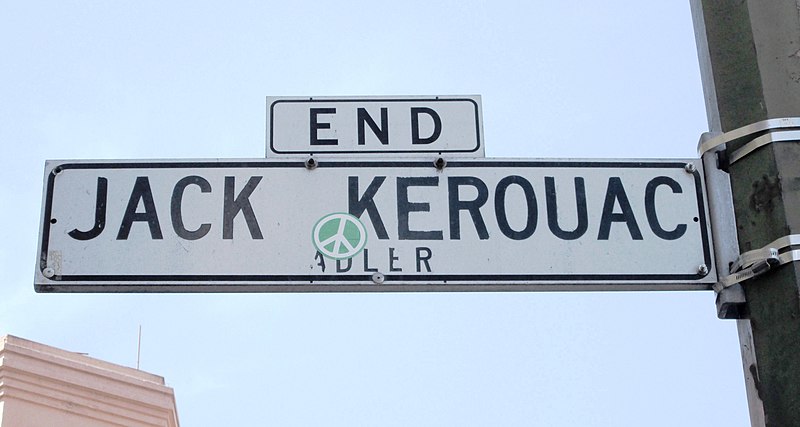Everyone is Waiting to Get ‘On the Road’ with Jack Kerouac
With vacation season quickly approaching while we are still in the midst of a global pandemic, people who are eager to journey outdoors, can read Jack Kerouac’s canonical novel, ‘On the Road, and bring a slice of travel and enlightenment into their own homes.
Beyond my Ken / Wikimedia Commons
Kerouac’s influence is still seen today, as he has an alleyway named after him in the North Beach neighborhood of San Francisco.
Attribution: Prosopee, CC BY-SA 3.0
Since 2020, the Coronavirus pandemic has immobilized many people, from travel-holic busybodies to anxious home-dwellers, instilling an intense urge to go out and explore the world, post-pandemic. Since we still cannot leisurely travel without potential exposure to COVID-19 and ever changing travel restrictions, we can look back into literature, specifically Jack Kerouac’s enigmatic novel about his travels, On the Road, to get the same sense of enlightenment that a stimulating trip would provide.
Jack Kerouac was one of the founding writers of the Beat Generation literary movement. The Beat movement originally started out as an intimate group of notable writers such as Allen Ginsberg and William Burroughs. Their world consisted of many societal highs, as the Great Depression had just ended and Americans were coming back home with a World War II victory. Beat writers sought to rebel against conventional American life and materialism.
Kerouac’s On the Road is often regarded as the pinnacle of the movement. The celebrated novel is centered on Kerouac’s (depicted as Sal Paradise in the novel) journey traveling throughout America with his partner-in-crime and idol, Dean Moriarty (a character based on fellow beat writer Neal Cassady). Paradise and Moriaty are depicted as reckless young adults infatuated with thrill, danger, love — essentially anything outside of the post-WWII mainstream.
Considering that the scroll of Kerouac’s original draft was sold in 2001 for $2.43 million, there is definitely some wisdom we can extract from the novel. In order to dive deeper, I reached out to Kerouac and beat generation expert, Dr. Regina Weinreich, who has dedicated her life to analyzing Kerouac and the beat generation movement, having written several works on such topics, with the most important being one of the first full-scale studies of Kerouac’s work that was published in 1987 by Southern Illinois University Press, Kerouac’s Spontaneous Poetics, along with other creative works in various mediums to give the public insight into the radical thoughts of Kerouac and his peers.
Dr. Weinreich started by saying, “The best way to understand Kerouac is not to think of him as a rebellious spirit but as a person who wanted the very, very normal things that were expected of him like maybe to marry the girl next door and lead a conventional life. But the conventions of that time were so narrow that that possibility really never happened for him. In other words, that spirit of rebellion really wasn’t about rebelling as much as finding a way to be who they were, at a time where who they were just didn’t fit in.”
Trips, vacation, and break are all times where people have the opportunity to isolate themselves and fully give into their inhibitions, just as Paradise and Moriaty do (sometimes not so peacefully) in the novel. By far, the most notable and important aspect of the novel is the relationship and dynamic between Paradise and Moriarty, a relationship that readers cannot help but admire, and many may want to replicate in their own lives. At first glance, you may ask yourself, why must I find someone to look up to as Paradise looks up to Moriarty (a character known for his escapades and having various relationships with several women); but if you set aside your preconceived notions of idols and admiration, you can find the deeper significance behind their relationship.
Paradise is fascinated by Moriarty’s spontaneous and reckless lifestyle, and this fascination is what allows Paradise to break out of his shell and let loose, something that we all could use after two years of the pandemic. Because of Moriarty, Paradise “had reached the point of ecstasy that [he had] always wanted to reach, which was the complete step across chronological time into timeless shadows, and wonderment in the bleakness of the mortal realm” (Kerouac, 173).
When asked about the relationship between Paradise (Kerouac) and Moriarty (Cassady), Dr. Weinreich said, “If you know literature and look at their lives, they (Jack Kerouac and Neal Cassady) had adventures together and Cassady was definitely a catalyst for Kerouac’s travels and adventures, but also for his language because he was a fast talking person who also had a way of expressing himself that Kerouac loved. It was not the traditional way of people expressing themselves. They were like knights, they were looking for identity, they were looking for a place to be.”
Aside from the eccentric relationship between Paradise and Moriarty, a deeper look into the book shows that Kerouac’s motives for writing this novel were not all too different from our motives for reading it. We could all use a break from modern society, where everyone is focused on the political climate, consumed by pop culture, or even just fixated on personal success. Just as we want to escape our own stuffy, discouraging lives, Kerouac wanted to escape his. Although the book was published in the 1950’s, the plot takes place in the late 1940’s where postwar spirit was high but so was societal conformity. Kerouac had this to say about such a world: “Besides, all my New York friends were in the negative, nightmare position of putting down society and giving their tired bookish or political or psychoanalytical reasons” (8).
Regarding the quote above, Dr. Weinreich offered a comparison to Mark Twain’s Adventures of Huckleberry Finn, “I wrote a book, it was my doctoral dissertation, called Kerouac’s Spontaneous Poetics, and it deals with these characters as archetypes, coming back to Mark Twain’s book, where you essentially have [Huck and Jim] on a raft on the Missisippi. When they come to shore, these two characters are able to reflect on the nature of the people and society around them…they are kind of removed from society around them and therefore, they can comment on society — or actually Mark Twain though these characters — they are able to reflect on the hypocrisy and craziness of American culture. Similarly, Kerouac as a literary artist takes this real life adventure and makes it literary, and the relationship between these two figures is, now they are driving fast in a car across America, it’s like the car becomes that raft.”

Attribution: Beyond My Ken, CC BY-SA 4.0 <https://creativecommons.org/licenses/by-sa/4.0>, via Wikimedia Commons
(Prosopee / Wikimedia Commons)
She continued,“My perspective on him is that all of his impulses were as a writer writing, and looking for a way to express the world as it was in flux around him. The time that he lived in, the post-WWII period, was a time of enormous changes in our culture. And so he was looking for a way to express that through his medium of writing, because he loved writing and was a writer, but he was looking for a language to do it in. It’s impossible to imagine him in this particular moment, but I do think that every writer in every period of time, especially when life is so challenging and demanding as in a pandemic, is going to want to be the one to be able to express freshly what this reality is all about.”
The novel can definitely soothe our tensions in the middle of the pandemic, but its history can also be used to shine a spotlight on the negative changes going on in our society today, even those that are not pandemic related. Dr. Weinreich wanted to stress another way that the book related to our society today.
She stated, “I was thinking about how terrified Kerouac was just before the publication of On the Road, because Allen Ginsberg Howl was banned. The recent banning of Maus, by Art Spiegelman is also important. I don’t think this is pandemic related, but it is something that we all should be absolutely extremely worried about, which is censorship. Kerouac was worried about On the Road not ever being published because he thought it would be banned just like his friend’s work. People were deciding that the language was obscene and taking these books to court for that reason, and these books had to be supported, which ought to say something to what happens when you ban books…we fortunately live in a democracy and we need to support and fight for the right to have literature taught, particularly if these works are valuable, and they are.”
Though originally published on September 5th of 1957, On the Road continues to provide perceptive relief to those in times of trouble. Not only does the novel give us reasons to persist through times like these, but looking into Kerouac’s personal life and time period teaches us to create inspiring relationships with others and reminds us to constantly push ourselves to question the norms of our society, a way for us to make our mark in an ever-changing world.
“It was not the traditional way of people expressing themselves. They were like knights, they were looking for identity, they were looking for a place to be.”
Soree Park is a Features Section Editor for ‘The Science Survey.’ Through her work editing Features articles and writing her own articles, she has...

